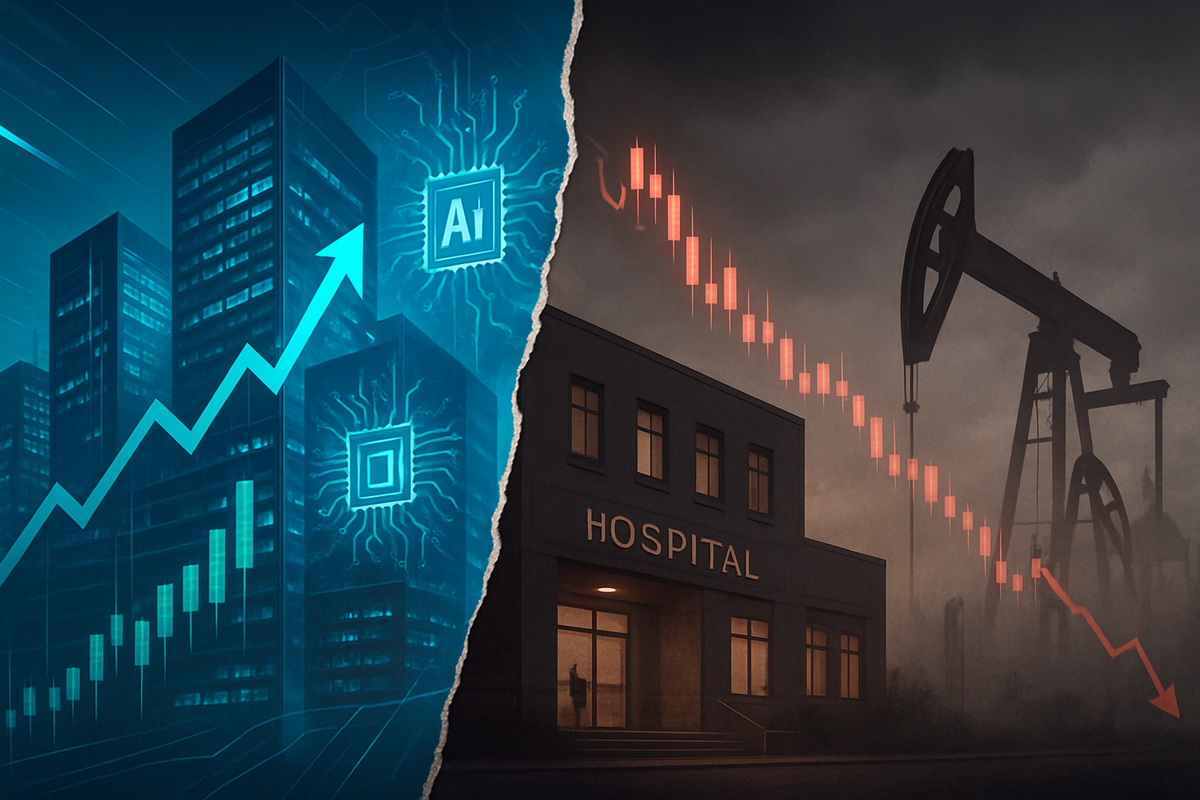
The current financial market is witnessing a stark divergence in sector performance, painting a complex picture for investors and the broader economy. While the technology sector, particularly its AI-driven segments, continues its meteoric rise, alongside robust showings from Utilities and Financials, other traditionally stable sectors like Healthcare, Energy, and Industrials are contending with significant challenges. This disparity is not merely a short-term fluctuation but reflects profound shifts driven by technological innovation, evolving energy demands, and a changing macroeconomic and regulatory landscape.
The immediate implications are clear: capital is flowing towards areas of perceived high growth and defensive stability, while sectors facing policy uncertainties, commodity price volatility, or structural economic slowdowns are experiencing a pullback. This "great divide" necessitates a nuanced understanding of underlying drivers and potential future trajectories to navigate the market effectively.
The Unfolding Story: AI's Ascendancy and Structural Shifts
The current market dynamic is a story of technological revolution meeting economic recalibration. The Technology sector, propelled by the relentless march of Artificial Intelligence, has become the undisputed leader. Major breakthroughs in generative AI and large language models (LLMs) from companies like OpenAI, Google (Alphabet, NASDAQ: GOOGL), and Anthropic have not only captured public imagination but have also driven unprecedented demand for underlying hardware and cloud infrastructure. NVIDIA (NASDAQ: NVDA), with its dominant position in AI GPUs, has seen its market capitalization soar, highlighting the critical role of specialized hardware. Cloud providers such as Microsoft (NASDAQ: MSFT) Azure, Amazon (NASDAQ: AMZN) AWS, and Google Cloud are expanding rapidly to meet the surge in data center demand, underscoring the foundational importance of their services. The timeline, from ChatGPT's (November 2022) public release to the ongoing advancements of Gemini, Claude, and agentic AI solutions in 2025, illustrates a continuous cycle of innovation and adoption that is fundamentally reshaping how businesses operate.
Simultaneously, the Utilities sector, traditionally a defensive haven, has found an unexpected growth engine. Decades of stagnant electricity demand have been abruptly reversed by the massive power requirements of AI data centers, the broader trend of electrification in transportation and heating, and a resurgence in domestic manufacturing. Projections from Goldman Sachs indicate a potential 165% increase in data center electricity demand by 2030, transforming utilities into critical infrastructure providers for the digital age. This has led to massive capital expenditures for grid modernization and renewable energy integration by companies like NextEra Energy (NYSE: NEE). The sector's outperformance, including a 16.0% year-to-date gain by August 2025, signals a revaluation driven by both defensive appeal and this newfound growth.
The Financials sector has also demonstrated resilience, benefiting from a stabilizing interest rate environment and a relatively robust economy. After aggressive rate hikes in 2022-2023, market expectations have shifted towards potential rate cuts in late 2025, which, coupled with improving credit quality and normalized loan demand, has supported the sector. Banks and other financial institutions have, for the most part, maintained strong capital positions, enabling increased dividends and share buybacks. Regulatory discussions, while ongoing, are leaning towards a potential for deregulation under a new U.S. administration, which could further buoy the sector. European banks, in particular, have exceeded earnings expectations, contributing to a broader market resurgence.
In stark contrast, the Healthcare sector has faced persistent headwinds. While long-term demographic trends suggest underlying strength, the sector has been impacted by rising operating costs, policy uncertainties around drug pricing reforms (e.g., ongoing discussions around President Trump's intentions to lower drug costs), and reimbursement rate cuts (as seen with Medicare Advantage in 2024). Companies like UnitedHealth Group (NYSE: UNH), Cigna Group (NYSE: CI), and Humana (NYSE: HUM) have felt the pinch of soaring reimbursement costs. Moreover, investor preference has shifted towards high-growth tech, leaving healthcare stocks undervalued, with the Health Care Select Sector SPDR Fund (XLV.US) down 3.7% year-to-date as of August 2025.
The Energy sector has been characterized by extreme volatility and overall underperformance. Despite temporary spikes in oil prices due to geopolitical events (like the Russia-Ukraine conflict in 2022), the sector faces structural risks from the global push for decarbonization and an expected oversupply relative to demand growth. Companies have struggled with fluctuating commodity prices and narrowing refining margins. While early 2025 saw a rebound in natural gas prices, the broader trend points to ongoing investor apprehension, with the Energy Select Sector SPDR Fund ETF (XLE) ending H1 2025 down.
Finally, the Industrials sector has presented a mixed, often struggling, picture. Global manufacturing downturns, persistent supply chain disruptions, and weakening demand have impacted many sub-sectors. The Purchasing Managers' Index (PMI) falling below 50 in early 2025 signaled contraction in manufacturing activity. While the 2021 Infrastructure Investment and Jobs Act (IIJA) has provided some tailwinds for infrastructure-related segments, other areas sensitive to higher interest rates, like construction, have faced difficulties. Companies like Caterpillar (NYSE: CAT) and Boeing (NYSE: BA), while not specifically detailed in their recent underperformance, operate within a sector grappling with a complex global economic environment.
Winners and Losers in the Shifting Sands
The current market dynamics are creating clear winners and losers, reshaping corporate strategies and investment horizons.
In Technology, the clear winners are companies at the forefront of AI infrastructure and development. NVIDIA (NASDAQ: NVDA) continues to dominate the AI hardware space, with its GPUs being the backbone of AI training and inference. Cloud computing giants like Amazon (NASDAQ: AMZN), Microsoft (NASDAQ: MSFT), and Alphabet (NASDAQ: GOOGL) are seeing massive demand for their cloud services (AWS, Azure, Google Cloud Platform) as AI development scales. Specialized AI software and service providers, such as OpenAI and Anthropic, are also thriving by deploying advanced models and securing enterprise partnerships. Conversely, losers include companies that are slow to integrate AI into their core operations or are outmaneuvered in the highly competitive AI landscape. Traditional businesses in sectors prone to automation may also face significant job displacement, becoming a "loser" in terms of workforce structure if they fail to upskill.
Within Utilities, companies aggressively investing in renewable energy and grid modernization are winning. Those partnering with tech giants to manage the immense power demands of data centers are particularly well-positioned. The electrification trend provides a strong, long-term tailwind. The losers are utilities heavily reliant on traditional fossil fuels, especially if policy shifts under potential new administrations make renewable energy adoption more expensive or curtail clean energy projects, as seen with some offshore wind project halts.
In Financials, European banks have shown strong performance, exceeding earnings expectations and contributing to a market renaissance, while certain consumer finance companies have also reported robust results, demonstrating resilience in navigating credit risk. The losers include companies highly sensitive to sustained higher interest rates, particularly some regional banks with exposure to commercial loans maturing at higher rates, which could see borrowers scaling back plans. Student loan servicers like Sallie Mae (NASDAQ: SLM) also show signs of struggle in specific lending segments.
The Healthcare sector sees winners in companies leveraging AI for drug discovery and development, benefiting from evolving regulatory frameworks that accommodate novel therapeutic modalities like cell and gene therapies. Companies focusing on rare diseases and advanced therapies, which often receive expedited approval pathways, are also well-placed. However, the sector has significant losers, particularly pharmaceutical and biotech firms exposed to potential policy changes, such as the proposed 25% tariff on generic medications from India and China, which could disrupt supply chains and raise drug prices. Mass layoffs at federal health agencies like the FDA could also slow drug reviews, impacting companies reliant on timely approvals.
In the Energy sector, companies that can effectively navigate geopolitical tensions and benefit from volatile natural gas prices are finding opportunities, with specific firms like EQT (NYSE: EQT) showing strong performance in H1 2025. The global energy landscape still presents a "tailwind" for some energy equities and futures. The sector's overall underperformance, however, creates losers out of companies heavily impacted by an expected oversupply of oil relative to demand growth, along with those that are less agile in adapting to the clean energy transition.
For Industrials, manufacturers benefiting from the 2021 Infrastructure Investment and Jobs Act (IIJA) and the "Build America, Buy America Act" (BABA) are clear winners, as these policies stimulate capital investment in U.S. industries and their supply chains. Companies involved in reshoring and near-shoring efforts to build resilient supply chains also stand to gain. Conversely, the losers are industrials sensitive to higher interest rates, such as the construction sector, where elevated borrowing costs make projects less economical. Companies heavily impacted by global trade protectionism and potential tariffs also face significant challenges.
Broader Implications: Reshaping Industries and Global Dynamics
The current sector divergence is more than just a market trend; it's a profound realignment with far-reaching implications across industries and the global economic order.
AI Adoption as a New Productivity Engine: The pervasive integration of AI is not merely enhancing existing capabilities but fundamentally rewriting industry playbooks. It's driving a "great divergence" risk, where companies and economies with advanced AI adoption will significantly outpace those lagging. This phenomenon is decoupling stock performance from traditional metrics, rewarding agile, AI-first strategies. The manufacturing sector, for instance, is heavily investing in AI to improve efficiency, productivity, and reduce costs, identifying cloud, generative AI, and 5G as key technologies for ROI. This will lead to competitive advantages for early adopters and potential disruption for those slow to adapt.
The Accelerating Energy Transition: The global energy transition presents "highly asymmetric" impacts. While high-carbon-emission industries face a "survival necessity" to decarbonize, sectors providing materials and infrastructure for renewables (e.g., mechanical engineering, basic metals, non-metallic minerals) are experiencing a boom. The massive estimated $120 trillion investment required for infrastructure between 2020 and 2050 signals a multi-decade cycle of growth for companies aligned with green initiatives, while compelling conventional energy companies to fundamentally adapt their business models. Climate transition risks, from carbon taxes to fossil fuel restrictions, are creating distinct effects on energy prices and valuations.
Economic Cycles and Fiscal Dominance: The traditional relationship between economic cycles and sector performance is being influenced by unprecedented levels of federal debt and legislative spending. This "fiscal-dominated landscape" can reduce the effectiveness of monetary policy, as increasing interest rates may inadvertently stimulate the economy through higher government interest expenses. This leads to a divergence where interest-sensitive sectors struggle, while those benefiting from fiscal spending or technological breakthroughs (like AI) demonstrate resilience. This shift hints at a departure from the monetary policy effectiveness seen in earlier decades, such as the 1970s.
Ripple Effects and Global Inequality: The competitive landscape is being reshaped, with AI early adopters gaining substantial advantages, potentially marginalizing rivals. Supply chains are undergoing retooling, benefiting providers for renewable infrastructure while challenging fossil fuel-tied entities. A fragmented implementation of AI could lead to "trade islands" and exacerbate global inequality, concentrating trade flows and economic gains in AI-driven centers. This echoes historical technological revolutions that widened the gap between advanced and developing economies.
Regulatory and Policy Crossroads: Governments globally are grappling with the implications. AI regulation, exemplified by the EU AI Act (implementing progressively from 2025), seeks to balance innovation with ethics, data privacy, and market concentration. Energy policy is being driven by climate change mitigation, with regulations like carbon markets and restrictions on fossil fuels. Financial oversight may need reassessment in a fiscally dominated environment to manage stability and inflation. Furthermore, healthcare reform, though not fully detailed, will continue to impact resource allocation and pricing, potentially creating further divergence within the sector.
Historically, this period draws parallels to past technological revolutions (like the internet boom), which created significant wealth divergence and necessitated new regulatory frameworks. The current valuation extremes in the tech sector are even compared by some to the late-1990s dot-com bubble, signaling a need for caution amidst the enthusiasm.
What Comes Next: Navigating the New Normal
The coming months and years promise a continuation of these diverging trends, demanding strategic pivots and a keen eye on emerging opportunities and challenges.
Short-term (2025) Outlook: The global economy is expected to experience a widespread growth slowdown in 2025, primarily due to new U.S. trade policies and higher tariffs, with global GDP growth projected at 2.9%, the slowest since the COVID pandemic. U.S. inflation is predicted to remain above target and could reaccelerate due to tariff costs. The Federal Reserve is likely to maintain a cautious stance on interest rates until late 2025 or early 2026, while other central banks might be more inclined to cut rates. This environment will likely continue to favor sectors aligned with structural growth drivers like AI and electrification, while placing further pressure on those susceptible to economic slowdowns and trade tensions.
Long-term (Up to 2030) Possibilities: The Technology sector, particularly AI, cloud services, and cybersecurity, will remain a primary growth engine, contributing trillions to the global economy. Healthcare and Biotechnology are poised for strong long-term growth due to aging populations and advancements in telemedicine and personalized medicine. Green Energy and Sustainability will see massive investments driven by net-zero goals and the demand for renewable infrastructure. The Industrials sector, benefiting from Industry 4.0 and global infrastructure spending, is expected to regain altitude. Conversely, commercial real estate faces long-term uncertainty, and the oil and gas sector grapples with a "disorderly energy transition" and subdued price outlooks.
Strategic Pivots and Adaptations: Companies across all sectors must embrace agility. The ability to pivot quickly, like Netflix's shift from DVDs to streaming, will be paramount. This means integrating AI and automation into supply chains, focusing on sustainability to attract customers, and diversifying revenue streams. The "China Plus One" strategy, diversifying manufacturing beyond China, will continue to reshape global supply chains. A customer-centric and data-driven approach is crucial to adapt to rapidly shifting demands. Only 10% of businesses are able to pivot quickly, highlighting a significant competitive advantage for those who can.
Emerging Market Opportunities and Challenges: Emerging markets will be critical, presenting significant opportunities in digitalization, sustainable development, and rising consumer demand, particularly in India, Vietnam, and Africa. However, geopolitical fragmentation, policy uncertainty (e.g., new U.S. tariffs), infrastructure gaps, climate change risks, and the need to upskill labor forces pose substantial challenges. Emerging markets may also see increased alignment into geopolitical blocs like BRICS+, altering traditional trade patterns.
Potential Scenarios and Outcomes: The prevailing scenario suggests a period of slowed global growth with divergent inflation, particularly with U.S. inflation potentially remaining elevated due to tariffs. Divergent monetary policies, with the U.S. Fed holding rates longer than others, are also likely. Geopolitical fragmentation and trade shifts will continue to transform business models, driving reshoring and supply chain resilience. AI will remain a central force, influencing equity markets and even bolstering sectors like utilities due to immense power demand. Companies that adopt "Always-On Strategy" models, emphasizing continuous adaptation and learning from real-time data, will maintain a competitive edge.
Conclusion: Navigating a Period of Profound Change
The current market environment is one of profound transformation, characterized by distinct winners and losers, and a fundamental reshaping of economic and industrial landscapes. The stellar performance of AI-driven Technology, the surprising resurgence of Utilities, and the resilience of Financials stand in stark contrast to the struggles of Healthcare, Energy, and parts of the Industrials sector.
Key Takeaways: The AI revolution is not a transient trend but a structural force driving innovation and investment. Utilities have transcended their defensive role to become critical infrastructure providers for the digital age. Financials demonstrate strength under stabilizing economic conditions. Conversely, healthcare faces policy-induced headwinds, energy grapples with volatility and transition, and industrials are sensitive to global economic slowdowns and trade tensions.
Market Moving Forward: The global economy faces a period of moderated growth, with potential headwinds from tariffs and elevated interest rates, particularly in the U.S. While a long-term bull market remains a possibility, especially if market leadership broadens beyond mega-cap tech, caution is warranted. Geopolitical fragmentation and a shift away from unfettered globalization will likely characterize the "brave new world" of investing.
Significance and Lasting Impact: This era signifies a re-evaluation of traditional sector roles and economic drivers. The interplay of technological innovation, energy transition, and evolving fiscal policies is creating persistent crosscurrents that will impact economic growth, inflation, and asset prices for years to come. The ability of companies and economies to adapt to these shifts will determine their long-term success.
What Investors Should Watch For: In the coming months, investors should closely monitor global GDP growth forecasts, inflation rates (especially the U.S. PCE index), central bank interest rate policies, unemployment data, and tariff developments. For investment strategies, diversification and selectivity are paramount. Opportunities may lie in small-cap stocks (Russell 2000), specific Communication Services segments, and defensive plays like high-quality Financial Services (regional banks, insurance, payment processors) and precious metals. Investors should also seek out Healthcare (biotechnology, medical devices) and Energy stocks that can provide a hedge against inflation or geopolitical risks. Caution is advised for the broader Financials sector due to potential overvaluation and for parts of Industrials due to economic deceleration. Most importantly, continuous adaptation and a deep understanding of the underlying structural changes will be crucial for navigating this dynamic and complex market.





